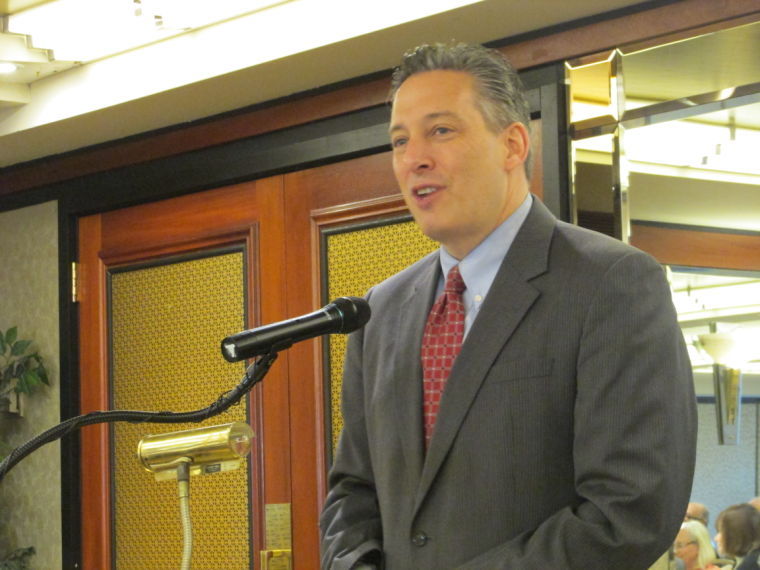Nassau Interim Finance Authority Chair Jon Kaiman said last Thursday that Nassau County’s finance are “structurally imbalanced” and the county needed to reform its tax assessment system to get out of debt.
“We are one of the wealthiest counties in America, in the world, and yet we are in a situation where our finances aren’t working,” Kaiman said in a presentation at a Great Neck Chamber of Commerce meeting last Thursday
Speaking at the Inn at Great Neck, the former Town of North Hempstead supervisor pointed to Nassau County’s property tax assessment system as one of the leading contributors to its continuing fiscal troubles.
“The future could look bright, but we do need to have a structural change to how we finance this county,” Kaiman said. “Because presently it’s simply not working.”
Kaiman said he will be meeting with Nassau County Executive Ed Mangano in the coming weeks to discuss ways to reform the property tax assessment system.
“It’s just a structural problem that nobody has had the political will to change,” Kaiman said. “We’re at a billion and a half dollars just paying off yesterday’s tax assessments.”
Nassau County received approval from the state Legislature to set taxable property values in exchange for a county “guaranty” of tax revenues to towns, school districts and special districts when property owners successfully challenged their taxes. Throughout most of New York state, property tax values are determined through city and town governments.
The successful challenges of homeowners and businesses has cost the county millions of dollars each year that the county has not accounted for in its annual budget, Kaiman said.
“Every year, we know we’re going to come up a couple million dollars short,” Kaiman said. “We’re at a billion and a half dollars paying off yesterday’s tax assessments.”
In 2010, the Nassau County Legislature repealed the county guarantee at the request of Mangano through a local law shifting the assessment costs to local municipalities.
While the law was upheld in state Supreme Court in 2012, the Appellate Division declared the law unconstitutional in February 2013 and in violation of the Home Rule Law, which places limits on the county’s ability to enact taxation laws.
Responding to a question about who has the authority to repeal the county guarantee, Kaiman said the state Legislature would have to pass legislation if the county wanted to repeal the law.
As town supervisor, Kaiman had joined with other towns, school districts and special districts in filing the challenge to the county.
Kaiman said he was also working the county to address a second major issue with the county’s finances – a three-year wage freeze on the county’s 7,500 union workers.
NIFA initiated the wage freeze in 201, which has saved the county $230 million, Kaiman said.
But Kaiman, who was appointed chair of the NIFA board by Gov. Andrew Cuomo late 2013, said the county could not ignored the terms of contracts signed with county workers and maintain that freeze forever. The union workers are currently suing for retroactive pay raises.
“The courts will eventually make us lift the wage freeze,” he said.
Kaiman said if the unions won in court before a deal could be worked out, it would cost the county more than $1 billion.
“We can’t sustain that risk,” Kaiman said. “We have an obligation to mitigate that risk.”
Kaiman said it has been his goal since taking over the NIFA board to “bring the unions together,” and find a way to lift the wage freeze.
Kaiman presented a four-page memorandum to NIFA board members on Feb. 4 outlining a plan to drop the wage freeze in exchange for each of county unions waiving three cost-of-living increases for 2011, 2012 and 2013.
The tentative agreement, which must be ratified by the NIFA board, is an unprecedented success in having unions agree to three years of no pay raises, he said.
“Nowhere else will you see a union accept three zeroes,” Kaiman said.
Kaiman said he expected that “NIFA is here to stay for a while,” but the board could not end the county’s fiscal distress.
“Nassau County ultimately needs to fix itself,” Kaiman said. “Hopefully this county will grow with the growing economy. It, too, will succeed and once again be one of the premier places in this country.”
Kaiman, who is also the chair of Long Island’s Superstorm Sandy recovery effort, said LIPA has recently received a $1.4 billion grant from the Federal Emergency Management Administration.



